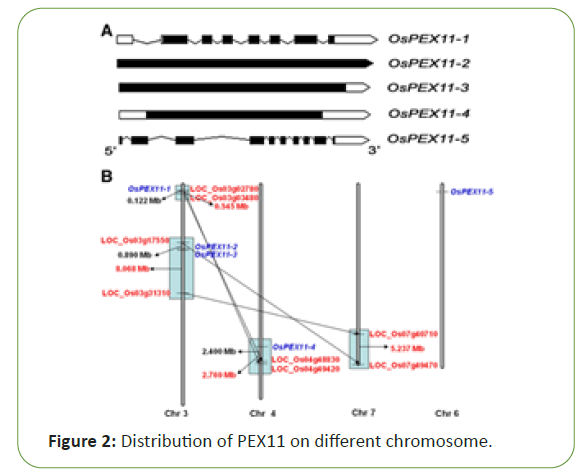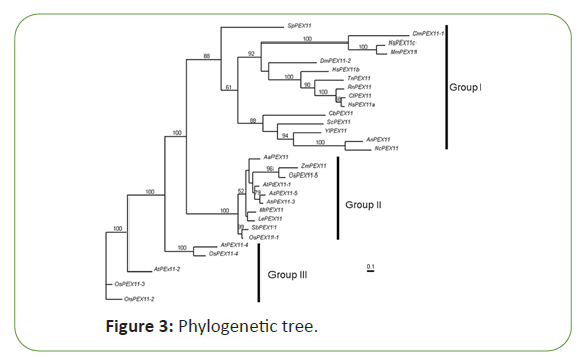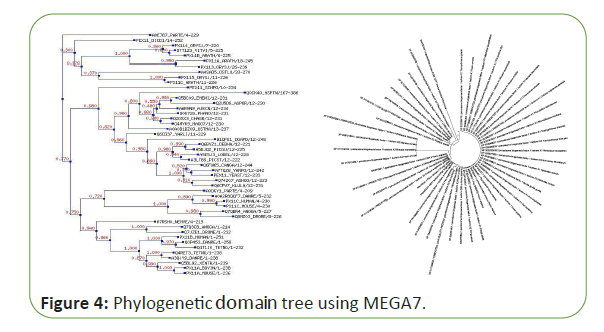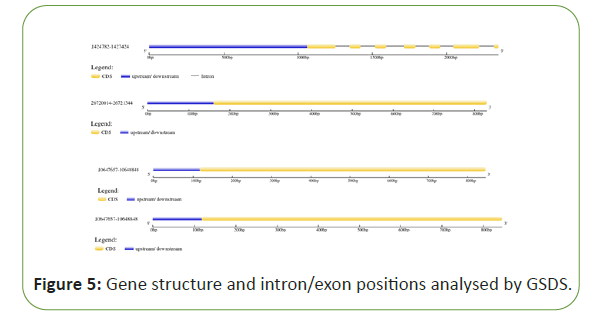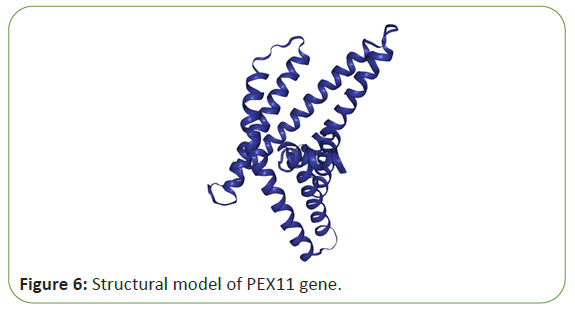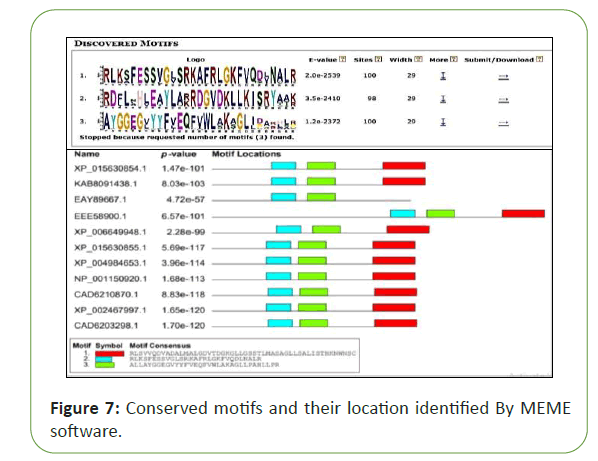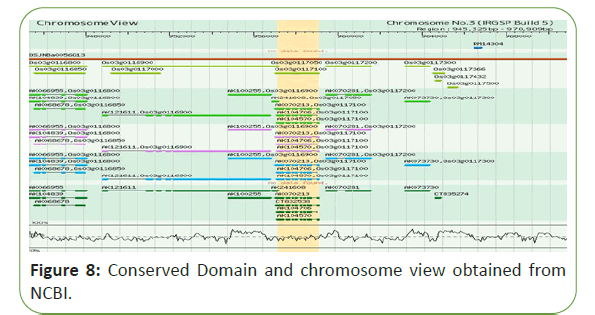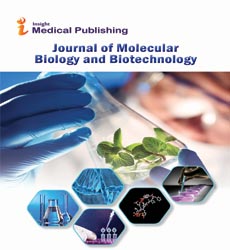Comprehensive Phylogenetic Analysis of -PEX11 Gene Family in Oryza sativa
Javeria Umber1*, Farukkh Azeem1 and Gulfam2
1 Department of Bioinformatics and Biotechnology, Government College University Faisalabad, Faisalabad, Pakistan
2 Department of Biotechnology and Genetic Engineering, National Institute of Biotechnology and genetic Engineering, Faisalabad, Pakistan
- *Corresponding Author:
- Javeria Umber
Department of Biotechnology and Bioinformatics,
Government College University Faisalabad,
Faisalabad,
Pakistan,
Tel: 03336230238,
E-mail id: javeriaumber474@gmail.com
Received Date: May 04, 2021; Accepted Date: May 18, 2021;Published Date: May 25, 2021
Citation: Umber J, Azeem F, Gulfam (2021) Comprehensive Phylogenetic Analysis of PEX11 Gene Famfily fin Oryza sativa. J Mol Biol Biotech Vol. 6 No.3: 03.
Abstract
Peroxin gene 11 has been revealed to have important functions involving photorespiration, beta degradation and peroxisomes biogenesis. In this study we show 5 assumed genes present in Oryza Sativa gnome PEX 11 (1-5) and each contains one conserved motif. The PEX 11 sequence from Oryza Sativa and other species are divided into three major categories. Despite of its important functions a very limited knowledge is known about PEX11 gene family in rice. This study confirms the five different PEX11 genes in rice and each gene contains one particular conserved domain. Among other members PEX11-2 and PEX11-3 are more closely related and shows recent duplications. Different analysis was done in this study to better understand the structure and phylogenetic relations of PEX11 genes and its evolutionary analysis. Our results showed that PEX11 genes have conserved domains but have diversification not only in sequences but also in functions.
Keywords
PEX11 gene; Phylogenetic Analysis; Oryza sativa; Evolutionary analysis; Peroxisome biogenesis
Introduction
Peroxins is a gene family which represents different protein families found in an organelle known as peroxisome [1]. Present in almost all eukaryotic cells, a peroxisome is a membrane bounded organelle having various functions and called oxidative organelles. Peroxin gene families are involved in different kind of functions such as cytoplasm protein recognition which contains PTS (per oxymel targeting signals). Peroxins tag these proteins and they are transported from cytoplasm to per oximes by peroxins. Being diverse in structure peroxins are classified into various protein families such as PEX1, PEX2, PEX3 etc. their major role is in the breakdown of fatty acids which are of long chains into smaller molecules through a process of beta oxidation. The long fatty acids are converted into medium chain fatty acid with the help of peroxins in animal cells. These medium sized fatty acids are then transported to mitochondria where they are broken down into CO2 and water. Deficiencies of peroxins are associated with several severe disorders [2].
PEX genes encode the protein machinery which is required by the proper assembly of peroxisomes. Proliferation of the peroxisome is regulated by PEX 11 whereas PEX 3, 16 and 19 are involved in assembly and maintenance of organelle. PEX 1, PEX 2, PEX 3, PEX 5, PEX 6, PEX 7, PEX 9, PEX 10, PEX 11A, PEX 11B, PEX 12, PEX 13, PEX 14, PEX 16, PEX 19, PEX 26 are the genes that encode peroxin proteins. The content of protein of the peroxisome varies in different organisms. The endo-symbiotic origin of peroxins was suggested because of the presence of these proteins in many species. It was assumed that peroxisomes were originated from bacteria as a result of invading larger cells as parasites. However, with the passage of time and with the recent discoveries this view of endo-symbiotic origin is challenged. Recent studies suggest that peroxisomes have action-bacterial origin. However, this suggestion is still controversial [3-14].
Peroxisomes are mostly spherical in plants. Plasticity in function is one of the remarkable features of peroxisomes in higher plants [15]. A large number of peroxisomes are involved in photorespiration, nitrogen metabolism, plant hormone metabolism and interaction of pathogens and plants [16-19]. In higher plants peroxins are highly conserved, among them PEX11 was the first to be isolated and is best understood. PEX 11 proteins are involved in proliferation of peroxisome in plants [20- 22]. The Absence of PEX11 in plants leads to the formation of two or more giant peroxisomes which than caused cessation of cell growth [20-23]. Similarly, over expression of PEX11 leads to the increased number of peroxisomes per cell [20-23]. Despite of the discovery of PEX11 10 years ago, its mode of mechanism is still not completely understood [24]. Rice is considered as one of the most important and model plant of monocot species for various genomic studies. However limited study and knowledge of PEX 11 gene is found in rice plant. In this paper PEX 11 sequences were identified and their phylogenetic analysis was done [2].
Materials and Methods
Recognition and sequence retrieval of PEX11 gene in rice
The sequences of PEX11 in rice were identified from National centre for biotechnological information. The sequence was used as a query in comparison to non-redundant sequence of protein in BLASTP program to get supposed peroxin 11 in rice and other species. All the sequences were than inspect for the conserved PEX11 domain by using the online tool called as a Simple Modular Architecture Research tool and PFAM domain, conserved domain was also identified by using NCBI. SMART and PFAM tools are used for the analysis of architecture and functions of domains and motifs. Multiple sequence alignment MSA was performed to confirm the conserved domains of PEX 11. The full length PEX 11 proteins from rice species were aligned using MEGA 7.0.21 and the evolutionary tree was built. A maximum likelihood tree was built and exported in newick format. Both kind of tree was exported i.e., circular and radiant. The tree was built in order to study the evolutionary relationship of PEX 11 gene in other species. The full chromosome detail of PEX11 was identified by using NCBI tool. All these steps were performed in order to remove all those sequences which are not conserved in terms of domains. All the genomic information of PEX 11 gene for example gene location on chromosome, protein length and their protein cDNA sequences were obtained from NCBI. In this study we show 5 assumed genes present in Oryza are genome and each contains one conserved motif. The PEX 11 sequence from rice and other species are divided into three main categories (Table 1).
| Proposed names | Gene Locus | Protein accession | RNA accession | Exons | Chr | ORF length | Amino acid length | Start of Genomic Location | Conserved domains in protein sequence |
|---|---|---|---|---|---|---|---|---|---|
| PEX11OS2 | LOC9267541 | XP_015630854.1 | XM_015775368.2 | 1 | 3 | 762 | 254 | 10645772 | pfam05648 |
| PEX11OS1 | LOC4331408 | XP_015630823.1 | XM_015775337.2 | 8 | 3 | 711 | 237 | 958077 | pfam05648 |
| PEX11OS3 | LOC4332579 | XP_015630855.1 | XM_015775369.2 | 1 | 3 | 726 | 242 | 10647657 | pfam05648 |
| PEX11OS4 | LOC4336511 | XP_015634264.1 | XM_015778778.2 | 1 | 4 | 666 | 222 | 26720014 | pfam05648 |
Table 1: Proposed nomenclature and important features of PEX11 genes.
Alignments, phylogenetic analysis and motif identification of peroxin11 gene family
Phylogenetic analysis and tree building by using both maximum likelihood and neighbour joining approaches was used to build evolutionary tree by using MEGA7.0 software. All the protein sequences obtained from BLAST from NCBI was subjected to CLUSTAL omega program using MEGA 7 tool. By using MEGA 7 phylogenetic tree was constructed. Different forms of rooted and un-rooted tree and branch length of tree as well as divergence time was obtained.
Analysis of structure of Gene and conserved domains and motifs
In order to confirm the conserved motifs of PEX 11 in different species a meme tool was used Multiple Em for Motif Elicitation. To illustrate the exon/intron organization the gene structure display server (GSDS) program which is an online tool was GSDS 2.0: an upgraded gene features visualization server.
Results
Sequence retrieval and evolutionary analysis of PEX11
All the sequence of PEX 11 gene family was retrieved from NCBI in Festa format. The retrieved sequences were subjected to NCBI- BLAST and all the available sequences in different organisms were downloaded. PFAM data base was used to inspect the conserved domains for the PEX-11 gene homologous in rice, Arabidopsis and other species. The results show that in rice PEX-11 has five members. These members are distributed on chromosome 1, 3, 4 and 6. About 100 PEX 11 homologous sequences were used for building phylogenetic tree. Results showed that PEX11 homologous sequences were divided into three main categories having further different subgroups. These three major groups include fungi mammals and yeast in group one and group two contains only plant species while group three contains Arabidopsis and rice. All these three groups are further classified into subgroups containing different number of species. From phylogenetic tree it is observed that OsPEX11-2 and OsPEX11-3 are more closely related than others. PEX11-2 and PEX11-3 have 85.25 cDNA similarities (Figures 1 and 2).
Phylogenetic analysis of PEX11 gene family
Phylogenetic analysis of PEX 11 gene family was done by using MEGA 7 software to generate evolutionary tree. Phylogenetic analysis was generated by using 100 sequences from different species. Results showed that PEX 11 gene family is broadly classified into many groups including yeast, fungi, animals and plants. Results showed that PEX11 homologous sequences were classified into three major groups having further different subgroups. These three major groups include fungi mammals and yeast in group one and group two contains only plant species while group three contains Arabidopsis and rice. All these three groups are further classified into subgroups containing different number of species. From phylogenetic tree it is observed that OsPEX11-2 and OsPEX11-3 are more closely related than others. PEX11-2 and PEX11-3 have 85.25 cDNA similarities (Figures 3 and 4).
Analysis of gene structure of PEX11 genes
The intron/exons positions remain conserved in orthologous genes with respect to evolution while in case of paralogous genes the structure of intron/exons are relatively less conserved. To analyse gene structure and position of introns and exons in PEX11 genes we compare their cDNA sequences and genomic DNA sequences by using online tool gene structure display server (GSDS) program, GSDS 2.0: an upgraded gene features visualization server. The gene structure shows that introns are less overall while there is much exotic region. The overall gene structure model of PEX11 gene was also obtained from Rosetta software. We get results and analysed that Oryza ativa both have five members of PEX11 gene family. the distribution of five members of PEX11 in rice are on chromosome 3 (1-3) ,4 AND 6. Among these PEX11-2 and PEX11-3 are more closely related and undergoes recent duplications. We analysed the genome structure of PEX11 gene family by using GSDS and compares their genomic vs. cDNA sequences and found that coding sequences of PEX11-2, 3, 4 are not interrupted by non-coding sequences (Figures 5 and 6).
Figure 6: Structural model of PEX11 gene.
Analysis of conserved domains
Analysis of conserved domains of proteins could help to understand protein functions exactly. The conserved domains were analysed by using different software such as pFAM, MEME. As a result, only one conserved motif was identified. Along with conserved domains, the full chromosomal map of PEX11 genes was obtained from NCBI. Results from PFAM analysis suggest that all the members of PEX11 gene family in rice contain one particular conserved domain. Expasy analysis gives us results which shows that there is a great variation in chemical properties of all these five members. Analysis was also done by using MEME program which shows three different motifs. Theses motif locations were well matched with the conserved sequences obtained from MSA (Figures 7-10).
Figure 8: Conserved Domain and chromosome view obtained from NCBI.
Discussion
Peroxisomes were involved in detoxification of cells by decreasing expression level of oxygen. But this was poisonous to various other life forms. Later on, peroxisomes were evolved to take various other functions such as photorespiration and beta oxidation. At first peroxisomes were identified in mice but later on its presence in other species was confirmed. In this research PEX11 sequences from 101 species are obtained which contains conserved domains from three large group’s i-e fungus, mammals and plant species. It is concluded from phylogenetic analysis that the PEX11 genes had a single origin and later it was evolved independently. Among these three groups the PEX11 gene family seems to be species. However, recently several gene duplications occur in PEX11 gene family. These duplications show that OSPEX11-2 and OSPEX11-3 becomes part of chromosomes 3 recently. Several rounds of genomic duplications have been found in all species of rice. We get results and analysed that Oryza ativa both have five members of PEX11 gene family. the distribution of five members of PEX11 in rice are on chromosome 3 (1-3), 4 and 6. Among these PEX11-2 and PEX11-3 are more closely related and undergoes recent duplications. We analysed the genome structure of PEX11 gene family by using GSDS and compares their genomic vs. cDNA sequences and found that coding sequences of PEX11-2, 3, 4 are not interrupted by non-coding sequences. Results from PFAM analysis suggest that all the members of PEX11 gene family in rice contain one particular conserved domain. Expasy analysis gives us results which shows that there is a great variation in chemical properties of all these five members. Analysis was also done by using MEME program which shows three different motifs. Theses motif locations were well matched with the conserved sequences obtained from MSA. This study helps to the better understanding of PEX-11 gene family in rice. Still there requires a lot of room of experiments for further analysis and understanding of PEX11 gene family in plants.
Conclusion
This study represents several members of PEX11 genes in different species particularly in rice spread on different chromosomes. This gene is highly conserved in plants mammals and fungi. The highly conserved manner of PEX11 gene family reveals that it has important functions in diverse taxonomic groups. Different analysis gives us the complete map of PEX 11 gene, its phylogenetic relationship, intron/exon locations, structure of gene as well as conserved domains which is helpful for further study of PEX11 gene family functions. Since till now there is a little knowledge about PEX11 gene family due to limited study and experiments, this study may help to better understand the functions of PEX11 gene.
References
- Crookes W J, Olsen L J. (1999) Peroxin Puzzles and Folded Freight: Peroxisomal Protein Import in Review. Naturwissenschaften 86(2): 51-61.
- Nayidu NK, Wang L, Xie W, Zhang C, Fan C, et al. (2008) Comprehensive sequence and expression profile analysis of PEX11 gene family in rice. Gene 412(1-2): 59-70.
- Schrader M, Costello J L, Godinho L F, Azadi A S, Islinger M, et al. (2016) Proliferation and fission of peroxisomes - An update. Biochim Biophys Acta 1863(5): 971-983.
- Lazarow P B, Fujiki Y. (1985) Biogenesis of Peroxisomes. Annual Review of Cell Biology 1: pp 489-530.
- Saleem R A, Smith J J, Aitchison J D. (2006) Proteomics of the peroxisome. Biochim Biophys Acta 1763(12): 1541-1551.
- Eberhart T, Kovacs W J. (2018) Pexophagy in yeast and mammals: an update on mysteries. Histochem Cell Biol 150(5): 473-488.
- Shai N, Schuldiner M, Zalckvar E. (2016) No peroxisome is an island - Peroxisome contact sites. Biochim Biophys Acta 1863(5): 1061-1069.
- Effelsberg D, Zaragoza L D C, Schliebs W, Erdmann R. (2016) Pex9p is a new yeast peroxisomal import receptor for PTS1-containing proteins. J Cell Sci 129(21): 4057-4066.
- Yifrach E, Chuartzman S G, Dahan N, Maskit S, Zada L, et al. (2016) Characterization of proteome dynamics during growth in oleate reveals a new peroxisome-targeting receptor. J Cell Sci 129(21): 4067-4075.
- Fagarasanu A, Fagarasanu M, Rachubinski R A. (2007) Maintaining Peroxisome Populations: A Story of Division and Inheritance. Annual Review of Cell and Developmental Biology 23(1): pp 321-344.
- Schlüter A, Fourcade S, Ripp R, Mandel J L, Poch O, et al. (2006) The Evolutionary Origin of Peroxisomes: An ER-Peroxisome Connection. Mol Biol Evol 23(4): 838-845.
- Gabaldón T, Snel B, Zimmeren F V, Hemrika W, Tabak H, et al. (2006) Origin and evolution of the peroxisomal proteome. Biol Direct 1:8.
- Duhita N, Satoshi S, Kazuo H, Daisuke M, Takao S, et al. (2010) The origin of peroxisomes: The possibility of an actinobacterial symbiosis. Gene 450(1-2): 18-24.
- Gabaldón T, Capella-Gutiérrez S. (2010) Lack of phylogenetic support for a supposed actinobacterial origin of peroxisomes. Gene 465(1-2): 61-65.
- Mano S, Nakamori C, Hayashi M, Kato A, Kondo M, et al. (2002) Distribution and Characterization of Peroxisomes in Arabidopsis by Visualization with GFP: Dynamic Morphology and Actin-Dependent Movement. Plant Cell Physiol 43(3): 331-341.
- Hu J. (2007) Plant Peroxisome Multiplication: Highly Regulated and Still Enigmatic. Journal of Integrative Plant Biology 49(8): 1112-1118.
- del Río L A, Sandalio L M, Corpas F J, Palma J M, Barroso J B, et al. (2006) Reactive Oxygen Species and Reactive Nitrogen Species in Peroxisomes. Production, Scavenging, and Role in Cell Signaling. Plant Physiol 141(2): 330-335.
- McCartney A W, Greenwood J S, Fabian M R, White K A, Mullen R T. (2005) Localization of the Tomato Bushy Stunt Virus Replication Protein p33 Reveals a Peroxisome-to-Endoplasmic Reticulum Sorting Pathway. Plant Cell 17(12): 3513-3531.
- Lipka V, Panstruga R. (2005) Dynamic cellular responses in plant–microbe interactions. Curr Opin Plant Biol 8(6): 625-631.
- Erdmann R, Blobel G. (1995) Giant peroxisomes in oleic acid-induced Saccharomyces cerevisiae lacking the peroxisomal membrane protein Pmp27p. J Cell Biol 128(4): 509-523.
- Passreiter M, Anton M, Lay D, Frank R, Harter C, et al. (1998) Peroxisome Biogenesis: Involvement of ARF and Coatomer. J Cell Biol 141(2): 373-383.
- Voncken J W, Roelen B, Roefs M, de Vries S, Marino S, et al. (2003) Rnf2 (Ring1b) deficiency causes gastrulation arrest and cell cycle inhibition. Proceedings of the National Academy of Sciences 100(5): 2468-2473.
- Marshall E S, Raichlen J S, Kim S M, Intenzo C M, Sawyer D T, et al. (1995) Prognostic significance of ST-segment depression during adenosine perfusion imaging. Am Heart J 130(1): 58-66.
- Thoms S, Erdmann R. (2005) Dynamin‐related proteins and Pex11 proteins in peroxisome division and proliferation. FEBS J 272(20): 5169-5181.
Open Access Journals
- Aquaculture & Veterinary Science
- Chemistry & Chemical Sciences
- Clinical Sciences
- Engineering
- General Science
- Genetics & Molecular Biology
- Health Care & Nursing
- Immunology & Microbiology
- Materials Science
- Mathematics & Physics
- Medical Sciences
- Neurology & Psychiatry
- Oncology & Cancer Science
- Pharmaceutical Sciences

